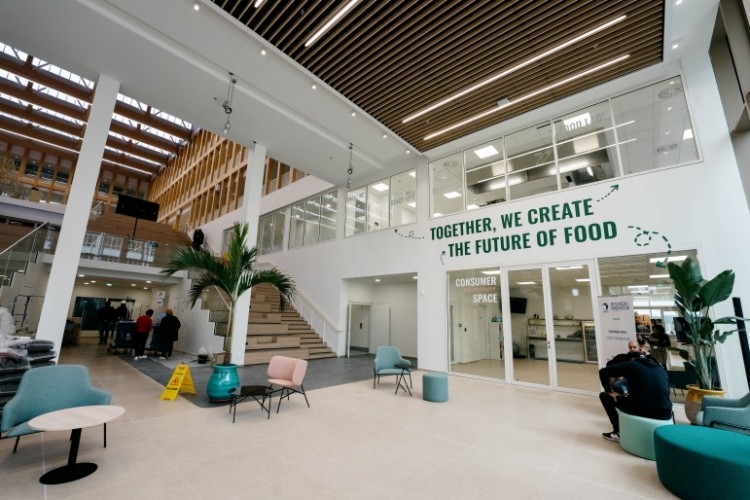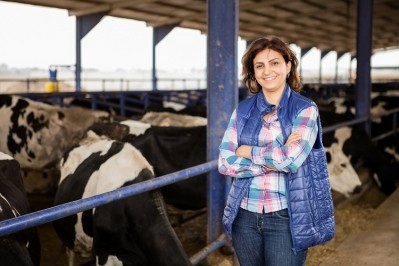'Putting science and technology back at the centre of innovation': Inside Danone’s new R&I centre

Danone has established a new research centre dedicated to the development of its fresh dairy and plant-based brands as well as its mineral water category. The site will initially be home to 550 researchers with expertise in life sciences, fermentation, nutrition and health, as well as specialists in consumer research, social sciences, packaging and production. Facilities include a consumer lab, a life sciences lab that houses Danone’s collection of 1,900 strains of ferments, an analytics lab and a pilot production plant.
Presiding over the official ribbon cutting, French Prime Minister Elisabeth Borne said Danone’s approach aligns with the objectives of the French government to nurture a food environment that is better for people and the planet. “The food and ecological transition will lead to better and healthier food. That is the ambition of my government,” Borne told the audience.
The investment is a ‘bet on the future’ at a time when France wants ‘to achieve food sovereignty’, she continued, noting that recent events have demonstrated the importance of investing in the food system in France. The COVID-19 pandemic highlighted ‘weaknesses’ in the food chain while the energy crisis is hitting food producers, the Prime Minister observed. Heatwaves, fires, and droughts ‘are threats to our farms and remind us of how quickly we should act’.
And French policy makers are indeed taking action to increase resilience in the food system, the politician maintained. “Acting means facing inflation and the energy crisis,” she said, adding that the authorities are ‘increasing the competitiveness’ of France’s economy by lowering corporate taxes and providing ‘better visibility’ for economic stakeholders. By the end of the year, the French government will have invested €2bn in agriculture and nutrition with the aim of supporting sustainable production, biodiversity and climate, identifying new foods through initiatives like Ferments of the Future, in which Danone is a participant.
“This research centre is the future of health through nutrition. It will design products that will help us do better by eating better,” Borne predicted. “Your research and work contribute to shaping the future of our country.”

Danone CEO Antoine de Saint-Affrique echoed the significance of the investment to the future of food. “The history of Danone is intrinsically linked to science. Science in health and science in nutrition… The mission of our company is taking nutrition to the largest number of people. This is a huge ambition and a tremendous responsibility that has its roots in science…This site is looking towards the future,” the chief executive noted.
“This official inauguration shows our willingness to invest in science and technology. This is a priority reflected in our investments, partnerships and acquisitions,” he said at the event. “Our ‘Renew Danone’ strategic plan puts science and technology back at the centre of innovation, making them key growth drivers for the company.”
Fermentation expertise shapes Danone’s R&D priorities
The Daniel Carasso Center will focus its research efforts on five main areas: consumers and patients, products focused on health and taste, collaboration in science and technology, packaging innovation, and digital data.
These priorities align with Danone’s ‘One Planet, One Health’ mission to develop nutritious products for as many people as possible. Saint-Affrique hopes Danone’s researchers will find answers to important questions facing the food sector: “How can we meet the diverse [nutritional] demands of a growing global population? How can we [achieve this] when resources are becoming scarce?" This difficult equation can only be solved through science, he concluded. “Research is of paramount importance to optimise the use of raw materials without any waste, while maintaining their intrinsic nutritional quality.”
Technology, innovation, and R&D are ‘powerful levers’ to deliver health, quality and ‘pleasure’, Saint-Affrique elaborated. “What is the use of offering products that are good for your health, but nobody eats because there is no pleasure?” he asked, explaining that innovation needs to be adapted to culture and lifestyle.
Topics Saint-Affrique flagged as significant for Danone’s research workstreams include ingredients, processes, bio-packaging and lifecycle nutrition for ‘big moments of life’. For example, Danone is examining growth biomarkers in children, solutions for older people, and research focused on the microbiome for immunity and gut health.
Central to Danone’s approach is the company’s expertise in fermentation. “Any solution coming out of fermentation is part of the game,” Taous Lassel, Danone Chief of Staff R&I and QFS, told FoodNavigator. Fermentation can be leveraged to alter the taste and texture profile of products, with potential uses in fat or sugar reduction; it can be used in food safety and quality; and it can deliver gut-health supporting microbes, an area Danone is already active in through the Activia and Actimel brands. Elsewhere, Danone is collaborating with the Bill & Melinda Gates Foundation and unnamed universities to examine whether fermentation can be leveraged to make plant-based products healthier by combating antinutrients that inhibit the body’s ability to absorb iron.
“We received a grant from the Bill & Melinda Gates Foundation to test an approach to enhance iron absorption from fortified food in children by using food-grade bacteria producing phytase to mitigate the adverse effects of phytates (present in most cereals). We will carry out this work with renown academic partners,” we were told.
The importance of collaboration and transparency
This kind of collaboration with external partners including academia and start-ups is becoming an important theme in Danone’s R&D strategy reflecting a more ‘balanced approach’ to innovation, Lassel said. “The way industry used to work was: ‘I find a solution, I own it, I patent it’…. In some areas we’d like to be the first to market. But there are some areas where we believe collaboration is the answer.”
In particular, Lassel believes that longer-term objectives within the group’s innovation pipeline provide fertile ground for collaboration. The work Danone and partners are undertaking to develop protein ‘beyond plant-based’ through synthesised and novel proteins stands as case in point. Lassel suggested this research represents a long-term innovation effort where collaboration with universities and start-ups plays an important role. Precision fermentation, for example, ‘is one of our research programmes’, Lassel confirmed. “It is looking promising,” she added.
Elsewhere, the ‘future of food for people who are 50+’ is a medium-term R&I priority with a 3- to 5-year horizon. “My personal opinion is this is [healthy ageing] is something we need to address collectively. Nobody wants to be targeted as a healthy senior. There is a challenge to find the right positioning from an emotional point of view,” she noted.
An increasingly collaborative approach to innovation also means higher levels of transparency, particularly in light of Danone’s consumer lab that aims to facilitate the co-creation of solutions. “This is like a rebirth, imposing something newer, more transparent and deeply connected to the consumer. Everything is open, there are no closed doors,” Lassel reflected.
Green by design
Alongside Danone’s ambition to produce products that are good for people, the French food giant wants to do this in a way that is also good for the planet. Green technology has therefore been built into the design of its newest innovation facility, which features wooden frames, photovoltaic panels, geothermal heating and cooling, and a water recovery system. These initiatives make the building the ‘first-ever’ European research centre to hold the low carbon label, Danone revealed.
This aligns Danone’s investment with the objective championed by the French government to drive a green transition in food production, FoodNavigator heard. “Green industries are the key for our growth in the future… economic development and environmental transformation go hand in hand,” Prime Minister Borne maintained.
From a policy perspective, this transition will require a ‘fair’ distribution of resources down the supply chain as well as the safeguarding of France’s producers who are investing in ecological production from cheaper, less environmentally friendly imports, she suggested. “We need to produce food in a sustainable and fair way and make sure all players get their share,” Borne insisted. “Many producers fear the impact of environmental objectives on [their] competitiveness,” she noted insisting that France will ‘protect our producers’ from those who don’t ‘adhere to the same standards’ at an EU and global level through trade conditions.
![Danone_Saclay_-_Etienne_Boulanger_-_6[1]](/var/wrbm_gb_food_pharma/storage/images/_aliases/reference/media/images/danone_saclay_-_etienne_boulanger_-_6-1/16157399-1-eng-GB/Danone_Saclay_-_Etienne_Boulanger_-_6-1.jpg)


















